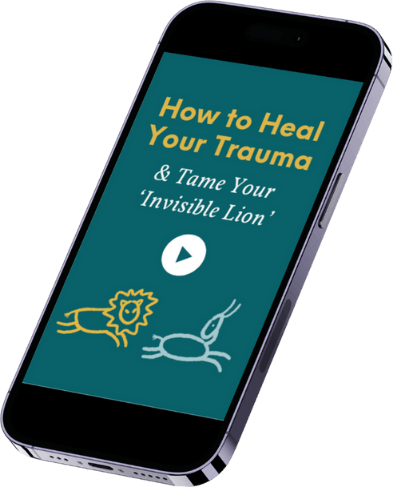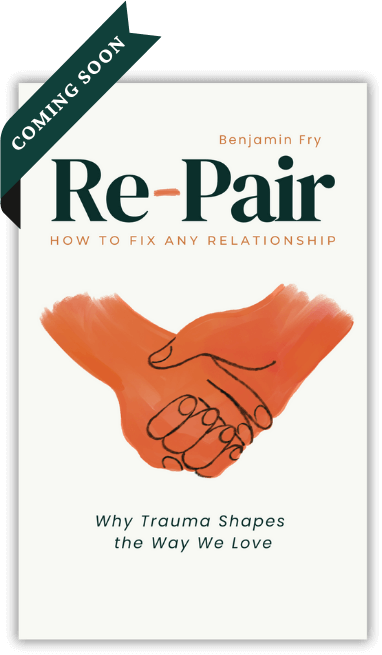In freeing ourselves from a dysregulated nervous system, an important step is learning how to reframe our experiences and manage our triggers, reactions, and baggage. We need to do this so that we are no longer subject to learned ways of behaviour that negatively impact our lives and the relationships we have with others.
The goal is to go from the diagram on the left below to the one on the right.

In the diagram on the left, in which our baggage is represented by the red squiggle, triggers are the green arrow, and our reaction is the red arrow, you can see a dysregulated nervous system – one that overreacts to the trigger. The diagram on the right represents a nervous system that is well regulated as a result of using boundaries and containment.
To reframe our experiences, we must bring attention to our triggers, our baggage, and our reactions. It’s easy to consider ourselves the victim in situations that trigger us and make us feel unsafe, but there is very little we can do to control what life throws at us. What we can do, however, is use boundaries and containment to lessen the impact that our triggers have on our baggage. When we do this, we create something like a shield around that vulnerable, wounded part of ourselves.
An example of how this works in practice is the story of Peter and his family, which goes as follows.
Peter went home to his parent’s house for Christmas. His brother and his sister are there, and his sister has brought along her new boyfriend, Frank. Peter’s family is quite tight-knit, but his parents are also fairly strict. There’s a certain way they like things to be done around mealtimes. Everyone helps to set the table and get the food served. Then they eat. Growing up, this was not optional, and his parents could be harsh if they felt he was not pulling his weight. On their first evening together, he noticed that Frank was not contributing to this at all. He just stood there chatting to Peter’s mother while everyone else worked around him. This happened again the next day. Twice, in fact, at lunch and dinner. By the evening, Peter was fuming. What should he say? Who should he even say it to? Does he have a problem with Frank, or with his mother, or with everyone? How can he process this experience?
Frank could identify his trigger by saying:
‘Hey Mum, I see you not saying anything to Frank when he doesn’t help and it feels like a trigger to me.’
He could then go on to manage his reaction to the trigger by adding:
“I notice how distressed I feel but I can’t even really explain it. I just feel uncomfortable and it makes me want to run away. But I don’t want to run away. I miss you guys.”
With this way of expressing himself, Peter brings his mother closer, rather than pushing her away. He’s having a hard time, but he’d rather be having a nice time instead, because he doesn’t see her that often. Hearing that, she’s likely to want to help him, not to push him away.
Now Peter can talk about his baggage.
“That’s how I always felt growing up when things seemed unfair. I think that’s why I moved away.”
What this brief snippet of conversation does is open up a window into the link between your nervous system, your behaviour and, therefore, your relationships. It puts this picture
into language that’s specific to that situation. And it keeps you in relationships while you do it. Staying connected is the very best thing you can do for your nervous system. It regulates you and gives you a chance to repair attachments. To be able to process unfinished business whilst staying connected is priceless.
In setting a boundary, Peter could say to his Mother:
“Can we talk about this more and see if maybe in future we can do things a bit differently? Otherwise I’m worried that I will continue to keep my distance to protect myself.”
The Importance of Listening
Let’s think for a moment how you would respond to this conversation if you were the one listening. It can seem like a bit of an odd dialogue. It’s not really how we normally talk. So, what would it be like to be spoken to like this?
Usually our reaction to something new and different is some form of resistance. We might be a bit alarmed. Add to this that we might easily hear these kinds of comments as if they are an attack, a judgement or blame, even when they are not. This might then become a trigger for the listener. And you know what can happen next if we then have our own reaction while listening to the first person’s reaction. We can get into a vicious cycle of mutual triggers instead of a healthy, regulating conversation.
The very best thing to try to do if someone is opening up to you like this is to listen. That might sound easy, but it’s actually one of the hardest things we ever do. Listening means hearing all the words and imagining what it is like to be saying them, rather than hearing just some of the words and then wanting to react or interrupt. Let’s be honest, most of us just react and interrupt most of the time. Even if we don’t actually interrupt the speaker with words, we interrupt our listening with our thoughts. Listening takes real effort. And guess what else? Practice, of course.
Clinically, we use a handy device for getting people to listen more deeply. We simply ask people to repeat back what they heard. When someone is listening to another’s vulnerable account of their nervous system, they know that at the end of it, they will be asked to try to repeat back what they heard, like a tape recorder. This focuses the mind on the task of listening, but it also shows up where it has been hard to listen. When the dialogue is reflected back to the first person, even if it is only partially accurate, it can be very reassuring for the person who spoke up to know that they have really been heard.
This is especially helpful for couples, for dispute resolution and for family work. If you find it hard to hear this stuff, or to be heard when doing it, this kind of exercise of repeating back what you have heard can be very effective.
You can download this post in a handy 2-page PDF to print and share with friends, family, clients or colleagues. Follow this link to download now.
You can buy a copy of The Invisible Lion now on kindle or paperback from your local Amazon store. Just click here to buy now.






